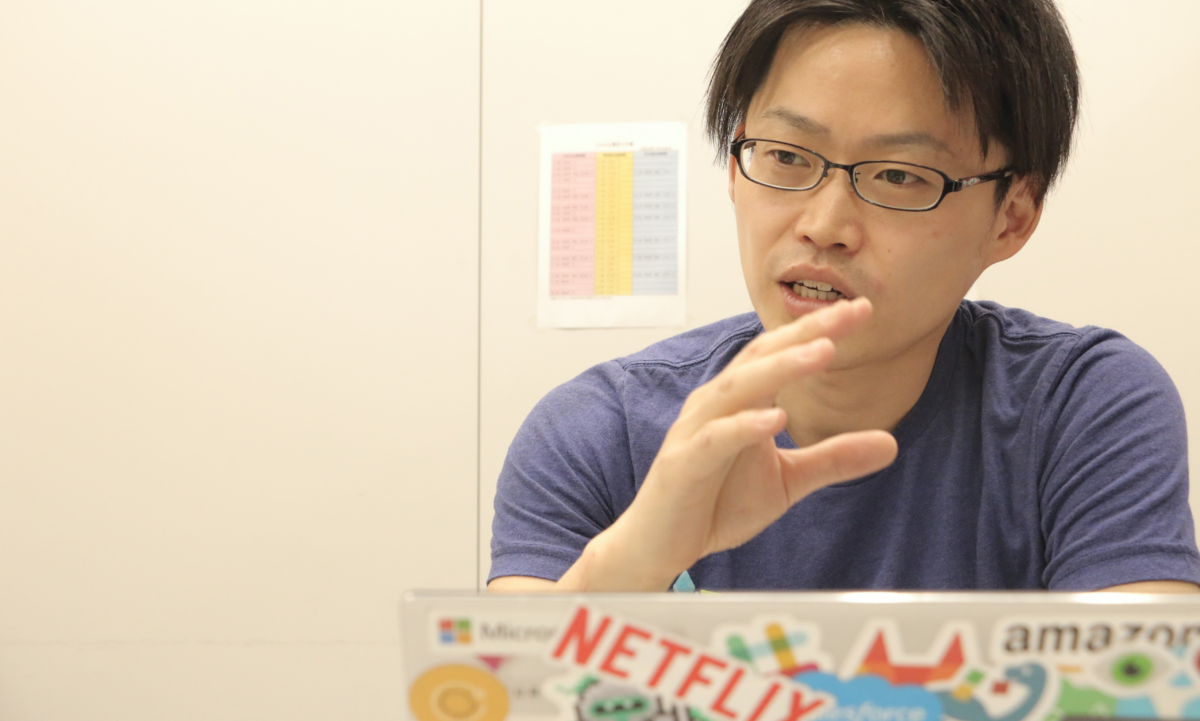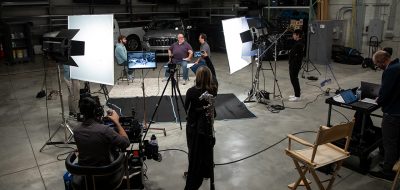In Video Addict Vol.2, we will be interviewing TV Tokyo, a pioneer in catch-up services (missed broadcast distribution services), together with Nippon Television Network Corporation, which we looked at in the previous installment of this series.
TV Tokyo is always at the forefront of new initiatives in the catch-up services industry, such as SSAI (Server Side Ad Insertion) (*1) and in-house app development. We will be speaking to Mr. Danno, a key figure in these initiatives, about his career to date and the launch of catch-up services.
Yuichiro Danno
TV TOKYO Communications Corporation
Video and Data Business Department, Tech Lead
Joined TV TOKYO in 2007. After working in the Systems Department, he gained experience in various production sites in the Production Technology Department. He then worked as a tech lead for video distribution services at TV TOKYO Communications Corporation. From 2019, he was in charge of planning and development and technical strategy planning centered on video distribution technology in the Distribution Technology Department at TV TOKYO.
## When I joined TV Tokyo as a new graduate, I wanted to be a cameraman
**Brightcove (BC) Tsuchiya**: From our perspective, it is our impression that it is Mr. Danno’s team that is implementing the first initiatives in the catch-up service industry. For example, I think there are things like implementing SSAI (*1) for simultaneous retransmission live, introducing a video-dedicated recommendation tool (Iris.TV), and in-house development of the “Net mo TV” app, which has the top share of commercial broadcast VOD apps, as well as offshore development, but with such industry-first initiatives, there is always a risk involved.
I think that a mindset that is not afraid of challenging projects cannot be gained overnight, so what kind of experiences have you had up until now?
**Mr. Danno of TV Tokyo (TX)** When I joined TV Tokyo as a new graduate, I wanted to be a cameraman and make TV programs because I liked TV, but the first department I was assigned to after joining the company was the Information Systems Department.
The main job of an in-house systems engineer is to prepare requirement definition documents and RFPs and organize the work of users, but my mentor was a skilled programmer who had switched from a development company at the same time, and he told me that “even if it’s an in-house system, if you want to create a better system, you need to have a deeper understanding of the technical side, even if you’re an in-house systems engineer”, so after getting permission from my superior, the two of us started to create various in-house systems in-house. I think that through the actual system development, I was able to gain a lot of experience in everything from the server side to the front end and databases, and I also think that I developed a challenging spirit at that time because I was willing to actively adopt new technologies even if they had little track record in order to achieve what I wanted to do.

**BC Tsuchiya** I think it’s quite a gap to be assigned to the Information Systems Department when you want to be a photographer.
**TX Danono** There was a gap, but I’ve always liked making things, and when I was at university I used to take videos, process them and edit them. It takes a lot of time, but I got feedback from users in the company saying things like “This system is much easier to use than the old one”, so it was worthwhile and it made me realize how much fun it is to make things.
**BC Tsuchiya** I see. So the mentor at the time had a strong influence on the department. This is not just true of Mr. Danno, but I also feel the same mindset in other people at your company, so it’s clear that the experiences you have when you’re young are important. How long were you in the Information Systems Department?
**TX Mr. Danno** Four years. After that, I worked as a photographer for four years.
**BC Tsuchiya** I think it was the department you always wanted to work in, but I think you had a hard time because your skill set was so different.
**TX Danjo** The IT skills I had learned up to that point couldn’t be directly applied to my work as a cameraman, and the culture was completely different, so it was hard. However, it was good that I was able to develop my awareness of the audience as someone involved in TV. Directors, cameramen and everyone involved in program production are thoroughly aware of the audience, and are always thinking about what kind of images the audience wants to see. This overwhelming awareness of the audience has been put to good use in the development of the current catch-up service, where we think about things from the user’s perspective, so I think I was able to gain a good experience.
Another thing that was important was developing a professional attitude. If I was even a minute late with a program, everyone else would be a minute late too. That delay would affect the production costs and there was a possibility that we wouldn’t be able to do the direction we wanted to do, so I learned that it was important to always have a professional attitude and to improve productivity as well as making better programs. I think that experience is also helping me now.
## Is there a way to make it easier for more people to watch programs?
**BC Tsuchiya** I see, so the program is produced with such a professional attitude. After that, you were transferred to TV Tokyo Communications, where you are currently working, right?
**TX Danjo** That’s right. As I said, producing a program is really hard work. Not just the camera crew, but everyone involved in the production is giving it their all to make sure that every frame is perfect and that the viewers enjoy it. I have a lot of affection for the programs I’ve worked on, and I want as many people as possible to watch them, but the reality is that young people are turning away from TV. When the ratings for the programs I worked on were poor, I felt frustrated, even though I was just a cameraman. TV recording devices are becoming more and more advanced, and there are even functions that allow you to watch recorded programs on your smartphone, but I was wondering if there was a way to make it easier for more people to watch programs… I was feeling frustrated. Then, in 2015, a plan to simultaneously broadcast “News Morning Satellite” live on the internet (at the same time as the TV broadcast) and a plan to broadcast catch-up videos with advertisements emerged, and I was recruited internally because I was thought to have a certain level of expertise in both information systems and broadcasting technology.

**BC Tsuchiya** Could you tell us about the team structure at that time?
**TX Mr. Danno**: Given that we had to launch the site within four months, the project owner was Ninagawa (currently a director at TV Tokyo Communications), and the team was made up of a small number of people from the content and technology departments. There was so much that needed to be done in such a short time, so there weren’t really any barriers between team members, and it was like a festival before the festival (lol).
**BC Tsuchiya** I think that with such a rush project, there are bound to be various problems at the start, but what do you think?
**TX Danjo**: With less than a month to go before the release, the video ad distribution server we had planned to use declared that it would not be able to provide support due to a lack of resources for various reasons at the company, so we had to urgently select a different ad server, which was really stressful. After deciding on the ad server, we had no time to spare, so we worked on it every night, even while sleeping.
The other thing is “iOS app problems”, but the app we developed didn’t pass Apple’s review… We received a lot of feedback from Apple about the UI/UX, etc., so for the time being we provided the service in a browser rather than as an app. At the same time, we fixed each of the issues one by one, and we were finally able to release it in June, two months later than planned.
## Raising the brand value of TV Tokyo through the catch-up service
**BC Tsuchiya**: The judging process was very strict at the time, wasn’t it? Since then, you have continued to provide the catch-up service up to the present day, but I heard that in the past, Mr. Danno said something along the lines of “It’s not easy for TV Tokyo to be number one in terms of viewer ratings. However, we want to show our presence on the internet”. How do you see the situation now, Mr. Danno? Also, if you have any future goals or secret strategies, please tell us about them.
**Mr. Danjo**: We are still halfway through, and we are constantly updating our future goals after discussing them within the company. In the past, we had a goal of being selected as the best app. Now, in addition to that, we are also conscious of raising the brand value of “TV Tokyo” or “TV Tokyo programs” through our catch-up service. When we surveyed the general public to find out what kind of image they had of our company, we were pleasantly surprised to find that they generally had a positive image of us. This is the result of our viewers watching our programs and feeling that they are “interesting” or “cutting-edge”. This image is a strength that we have built up since the station first opened, and we believe that it is an important factor in viewers choosing our programs and a source of our competitiveness.
In addition to broadcasting, the brand image is also important for new businesses in the future. For example, when Mercari launched its smartphone payment service “Mercpay”, many people who had used Mercari before thought “since it’s a Mercari service, it must be a good service” and tried it out because of its ease of use and good service. This can be said to be the strength of the Mercari brand. The image that makes viewers think “it must be interesting because it’s TV Tokyo” is a strength when it comes to being chosen from among the many competitors and getting people to watch, so we need to continue to work to maintain this image. If people have fewer opportunities to come into contact with TV Tokyo programs, they will no longer be reminded of this positive image, and we have a sense of crisis that this will lead to even fewer opportunities to watch than there are now.
I think that all services that bear the name “TV TOKYO” need to be approached with this awareness. For example, if the catch-up service app is not well-made, it will lead to a decline in the company’s image, so we are working hard to provide a better viewer experience, and we are also actively trying out new technologies to achieve this. First of all, I think that by getting more people to come into contact with our content and services through the catch-up service I am in charge of, and by improving our brand value as well as our revenue, we can improve the revenue of TV TOKYO as a whole.
Mr. Danjo believes that increasing the usage rate of the catch-up service will increase the number of viewers of the programs and enhance the brand value of TV TOKYO. In the second part of the interview (https://www.brightcove.com/ja/resources/blog/video-addict-vol2-tx-2), he talks about the company’s data analysis methods and its organization, which is constantly implementing industry-first initiatives.
*1 __SSAI (Server Side Ad Insertion):__ A method of inserting ads on the server side, as opposed to CSAI (Client Side Ad Insertion), which inserts ads on the client side. This method is expected to improve the ad viewing experience, reduce client-side development costs, and increase the number of ad inventories by disabling ad blockers.




